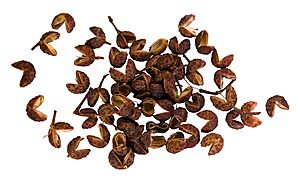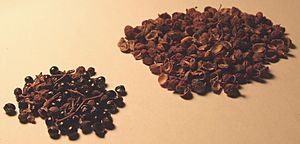Sichuan pepper facts for kids
Sichuan pepper (also called Szechuan pepper) is a special spice that comes from the outer shells of certain plant fruits. These plants belong to a group called Zanthoxylum. Many people in Asia grow them to use in cooking. Even though they are called "peppers," they are not related to black pepper or Chili pepper.
Sichuan pepper is very popular in food from Sichuan, China. That's where it gets its name! It's also used in food from Tibet, Bhutan, and Japan, among other places.
Contents
What does Sichuan pepper taste like?
Sichuan pepper has a very unique smell and taste. It's quite different from regular black or white pepper. It tastes a little bit like lemon. But the most interesting thing is how it makes your mouth feel. It creates a special tingling, slightly numb feeling!
When you cook with Sichuan pepper, recipes often say to lightly toast it first. Then, you crush it before adding it to your food. Only the outer shells (called hulls) are used for cooking. The small seeds inside are usually thrown away. It's best to add Sichuan pepper at the very end of cooking. Spices like star anise and ginger are often used with it.
Sichuan pepper is a key ingredient in spicy Sichuan food. It tastes great with fish, duck, and chicken dishes. It also goes well with fried eggplant. When you eat a lot of it, it can make your lips feel numb. A famous Sichuan flavor is Ma la (Chinese: 麻辣; pinyin: málà). This means "numb and hot" and is a mix of Sichuan pepper and chili pepper.
You can also find Sichuan pepper as an oil. This is sometimes called "Sichuan pepper oil" or "Hwajiaw oil." This oil is great for stir-fry noodle dishes that aren't too spicy. A good recipe might include ginger oil and brown sugar cooked with noodles and vegetables. Then, you add rice vinegar and Sichuan pepper oil after cooking.
Hua jiao yan is a mix of salt and Sichuan pepper. It's roasted in a wok until it's browned. This mix is served as a dipping sauce for chicken, duck, and pork. You can also lightly fry the peppercorns to make a spicy oil for different uses.
Sichuan pepper in other countries
Sichuan pepper is one of the few important spices in Tibetan and Bhutanese cooking in the Himalaya mountains. This is because not many spices can grow there. One special Himalayan dish is the momo. This is a dumpling filled with vegetables, cheese, or minced meat like yak, beef, or pork. It's flavored with Sichuan pepper, garlic, ginger, and onion. Momos are steamed and served with a fiery sauce. Tibetans believe it can help clean meat that might not be super fresh.
In Japan, people use the dried and powdered leaves of a plant called Zanthoxylum sancho. They add it to noodle dishes and soups to make them mildly hot and fragrant. Whole leaves, called kinome, are used to flavor vegetables, especially bamboo shoots. They also use them to decorate soups. The buds, seeds, flowers, and hulls of the plant are all used in different ways.
In Korean food, two types of Zanthoxylum plants are used: Z. piperitum and Z. schinifolium.
Import rules for Sichuan pepper
From 1968 to 2005, the United States Food and Drug Administration (FDA) stopped Sichuan peppercorns from being brought into the U.S. This was because the pepper plants are in the same family as citrus trees. They found that the peppercorns could carry a plant disease called citrus canker. This disease is very hard to control and could harm citrus fruit crops in the U.S. It was never a problem for people eating the pepper.
The ban was not always strictly enforced until 2002. But in 2005, the USDA and FDA lifted the ban. Now, Sichuan peppercorns can be imported if they are heated to about 70 degrees Celsius (160 degrees Fahrenheit). This heat kills the canker bacteria before the pepper enters the country.
- Recipes
-
Images for kids
-
Newly harvested Sichuan pepper (known locally as 大红袍花椒, dà hóng páo huā jiāo), left out to dry in the sun, Linxia County, Gansu Province, in Northwest China





